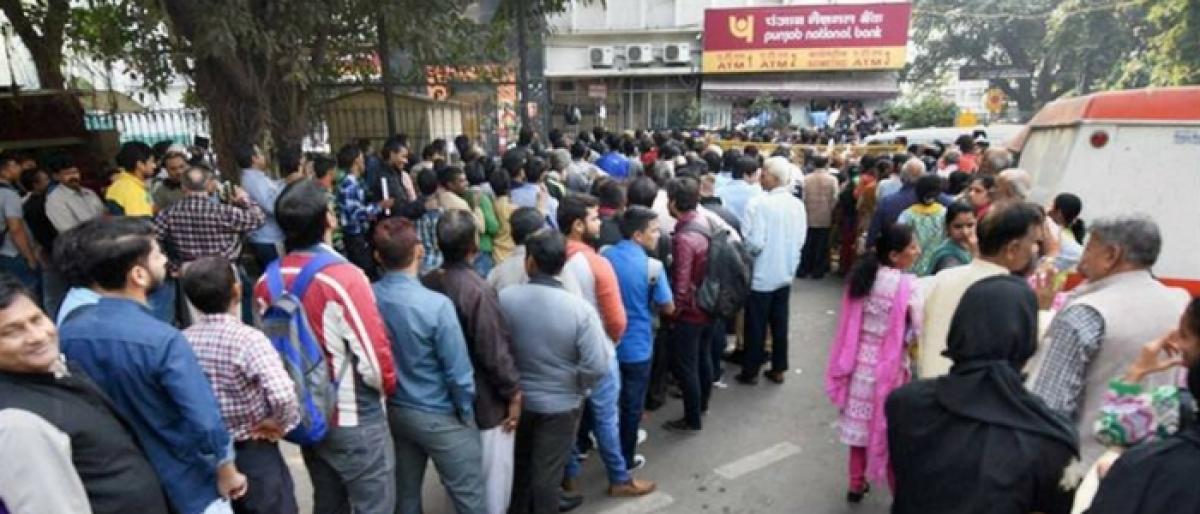Live
- Australia, Japan, US reaffirm commitment to support India's maritime surveillance in Indo-Pacific
- Officials inspect arrangements for CM’s visit
- Iran: 1 killed, 21 injured after bus overturns
- Welfare hostels shut as bills pile up
- CM Revanth Reddy Slams BJP Leaders Over Inaction
- Minister Ponguleti visits Basara temple
- Ashutosh Gowariker to lead International Jury at IFFI 2024
- The global challenges of greener aviation
- Shreyas Media secures exclusive advertising rights for ‘MahaKumbh Mela 2025’
- Experience the journey of art
Just In

A citizen Ramswaroop sought to know under RTI: a) how many persons exchanged old notes for new notes at Pinto Park post office and also at 3 Wing Branch of post office in Air Force area in New Delhi during the period 08.11.2016 to 25.11.2016 after demonetisation; b) total amount of new currency issued for the period 08.11.2016 to 01.12.2016 from both the post offices;
A citizen Ramswaroop sought to know under RTI: a) how many persons exchanged old notes for new notes at Pinto Park post office and also at 3 Wing Branch of post office in Air Force area in New Delhi during the period 08.11.2016 to 25.11.2016 after demonetisation; b) total amount of new currency issued for the period 08.11.2016 to 01.12.2016 from both the post offices; c) how many individuals exchanged the currency notes by producing their respective ID cards for the period 08.11.2016 to 01.12.2016 and sought addresses of all such individuals. The CPIO refused, saying that information is not available in consolidated form. First appeal also failed as the authority decided that this information is private information.
The pubic authority is expected to add up the currency exchanged on each day to arrive at ‘how much currency’ got exchanged, and how many individuals used ID to exchange, how many not, etc. That does not amount to creation of information.
The CPIO has not contended that it requires huge compilation that might disproportionately divert resources of the public authority as mentioned in Section 7(9) of the RTI Act, which says: An information shall ordinarily be provided in the form in which it is sought unless it would disproportionately divert the resources of the public authority or would be detrimental to the safety or preservation of the record in question.
Section 7(9) allows the Public Authority not to spend too much of resources on it, but mandates to spend reasonable time and energy to consolidate information sought. It is their daily routine to sum up the amount exchanged at the end of day or week or month, to report to their higher authorities.
He could have at least given the copies of such reports. The authority was non-responsive, evasive, negative and also amounts to irresponsibility. Surprisingly the First Appellate Authority took the ground of exception under 8(1)(j) of RTI Act, which was not raised by the CPIO. The FAA declared it was personal information without again applying his mind to the information sought and the law on that point. Except the addresses part, no other part of RTI application could be personal.
The Reserve Bank of India explained the public impact of the demonetisation in an official report, ‘Macroeconomic Impact of Demonetisation: A Preliminary Assessment,’ dated March 10, 2017, as follows: Demonetisation announced on November 8, 2016 was aimed at addressing corruption, black money, counterfeit currency and terror financing.
Although demonetisation holds huge potential benefits in the medium to long-term, given the scale of operation, it was expected to cause transient disruption in economic activity. The analysis in this paper suggests that demonetisation has impacted various sectors of the economy in varying degrees; however, in the affected sectors, the adverse impact was transient and felt mainly in November and December 2016.
The impact moderated significantly in January 2017 and dissipated by and large by mid-February, reflecting the fast pace of remonetisation. The latest CSO estimates suggest that the impact of demonetisation on GVA growth was modest. Currency squeeze due to demonetisation along with seasonal factors pushed food inflation significantly down but has not had much impact on inflation excluding food and fuel.
A surge in deposits led to a sharp expansion in the consolidated balance sheet of scheduled commercial banks and created large surplus liquidity conditions. These were managed by the Reserve Bank of India through a mix of conventional and unconventional policy instruments.
There has not been any significant impact on the external sector. There has been a sharp increase in the number of accounts under the Pradhan Mantri Jan Dhan Yojana and the deposits in such accounts have also surged. Financial re-intermediation may have received a boost following demonetisation. An important consequence of demonetisation has been the sharp increase in the use of digital transactions.
A management study group commented as follows: The Indian Economy which was billed as the “fastest growing major economy” in the world and the “only bright spot” among Emerging Markets seems to have slowed down even before the latest “shock therapy” of “demonetisation.”
Indeed, the recently released growth figures from the CSO or the Central Statistical Office considered to be the official department that releases projected, and actual growth figures (apart from the RBI or the Reserve Bank of India and the Finance Ministry) hints at a slowdown in the Indian economy even during the quarter before demonetisation happened.
While this is indeed cause for concern with projected growth figures revised downwards from 7.6 % to 7.1% for the financial year ending March 2017, what is cause for greater worry and even alarm is the view among some economists including the former Prime Minister Dr. Manmohan Singh (who is a reputed economist in his own right) that the current and ongoing attempt to flush out black money would shave a good 2% of the GDP or the Gross Domestic Product.
Indeed, some think tanks and research institutes such as Ambit Research have given even more dire assessments with their projections of growth figures tending to be in the less than 3% range. Of course, the consensus view among many economists is that while there would be indeed a noticeable slowdown in the economy for a “quarter or two,” most of them seem to agree that growth would indeed bounce back and the Indian economy would regain its momentum as well as turnaround with a renewed sense of vigour due to higher tax revenues.
Having said that, one must keep in mind the fact that as per the recent estimates by some economists, nearly 90% of the total cash in circulation has come back into the banking system and hence, the stated purpose of the Demonetisation exercise which was to “extinguish” black money and enable the RBI to lower its liabilities thereby providing the government with a huge dividend seems to have been belied.
Of course, there are some who now argue that the Indian Banking System is now “flush with cash” and this has enabled the government to “nudge” the RBI to cut rates as well as to allow banks to pass on the benefit of ample liquidity to consumers by lowering lending rates. (https://www.managementstudyguide.com/demonetisation-impact-on-indian-economy.htm)
Section 4(1) of RTI Act says: (c) publish all relevant facts while formulating important policies or announcing the decisions which affect public; (d) provide reasons for its administrative or quasi-judicial decisions to affected persons.
Every person’s economy was affected and even the beggar, rikshaw puller, push-cart seller and money-less poor reeled under this stroke.
If the suffering was just temporary and there will be windfalls in future, let that also be told to the people officially by each and every public authority concerned with the demonetisation. It is very difficult to reconcile with the attitude of building steel-forts that could not be broken even by Bahubali, around the public affair of demonetisation in a democratic nation, if governed by Rule of Law.
It is the duty of every public authority to spell out all relevant facts and reasons besides giving details at least in the post-demonetisation period. The CPIO should not have brushed aside this RTI request which reflected his blatant anti-transparency attitude. There is no reason for rejecting this information request.
All the public authorities have a moral, constitutional, RTI-based-democratic-responsibility to explain to each and every citizen, who is affected by demonetisation, the information, reasons, impact and remedial measures, if discovered any negative impact.
All the three points of information request could have been provided except the addresses or names of the persons who have exchanged the currency. If there is larger public interest, even the names could not be denied. If public authorities shy away from disclosing any information related to demonetisation, it will raise serious questions in the mind of general public.
The Commission directed to provide information about demonetisation as sought, except the address details of those who exchanged notes. (Based on decision in Ramswaroop v. PIO, Department of Posts, CIC/POSTS/A/2017/108193 on 18th May 2017)

© 2024 Hyderabad Media House Limited/The Hans India. All rights reserved. Powered by hocalwire.com







